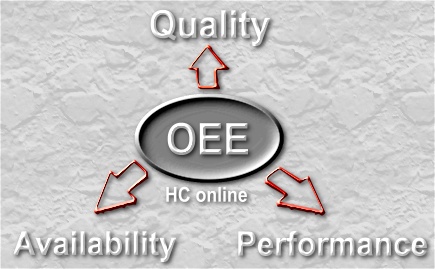OEE components
|

|
Last update: October 5th, 2008
|
Three components of OEE Overall Equipment Efficiency is a synthetic rate build upon three components, featuring three "dimensions", namely:
In the academic approach of TPM, OEE is built from and with different data, provides a convenient, simple and synthetic monitoring indicator. This easy monitoring helps to drive and take decisions, it's a typical manager's indicator. Conversely, it is possible to start from OEE and break it down in its components. The convenience of the compact OEE does not help identifying which component is the most performance limiting factor. Breaking OEE down in its three basic rates may be necessary for understanding, analysing and choosing the best action leverage for improvement. Three levers for actionOn what to focus for improving OEE? OEE value shows a global performance rate, to know what to do to improve it, where to focus attention, it is necessary to identify which dimension limits most the performance;
When starting TPM, it is common that all three dimensions limit significantly Overall Efficiency. In such a case, trying to solve all problems at once is non sense, as available resources (including time!) are always limited. Therefore, focusing on most limiting factor is necessary. Remember OEE is a ratio made of three intermediate rates;
These focused rates give figures about each contributing dimension, how they nag on or limit OEE. A first glance at these rates gives hints about which dimension is accounting for most of OEE limitation. Then it must be inquired why, by breaking down the components of the "gilty" rate. Zones for actionThe "zones" giving negative effects on OEE can either be:
According to troubleshooters location, it won't be the same person to take action. In TPM spirit, taking care of machines is operators job. Problems with interfaces are line manager or workshop manager's job. More widespread problems related to process can be adressed by operators with their supervisor(s) and eventually support of the manager in charge of the whole. External problems, limiting process or one of sub processes performance, must be adressed by concerned stakeholders. Feedback and explanations about consequences and countermeasures have to remain at manager's level. 
|
© C.HOHMANN
| This page is brought to you by ©hris HOHMANN - http://chohmann.free.fr/
| ||||||||||||||||||||||||||||
